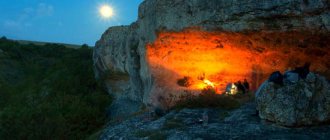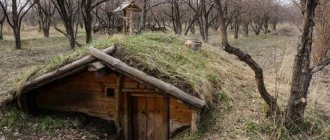Everyone living in a private house knows that a room is needed to store solid fuel for the winter. I suggest the option: “angle with a lifting roof.” This immediately begs the question: why with a lifting one? Based on my experience last year, when I had to throw coal into a coal pit, I realized that this is unpleasant work.
To make the square I needed:
profile pipe 20x40, 40x40, 50x50, 25x25 mm, door canopies, welding machine, electrodes, grinder, cutting discs for metal, level, tape measure, drill with drills, anchor bolts, pgs, cement, sand, concrete mixer.
To do this, I just needed to extend the parking area and I simply filled it and concreted it. On one side, instead of formwork, I laid out a brick “wall”, and on the other I laid an asbestos-cement pipe. Using anchors, I attached a “device” to the concrete base to hold the pillars, made from a 50x50 profile pipe, 200 mm long and a 3 mm thick metal plate with dimensions 150 x 150 mm.
No matter the size of the house, you can’t do without a shed on the site. Not everything can and should be brought into the house, even if there is space, and even if there is not, then even more so - outbuildings are necessary. By the way, this may be your first experience in independent construction: you can build a shed with your own hands without any skills. The main thing is that the hands grow from the right place.
If desired, the barn can be made to look like a small house
What materials are they built from?
If the shed is located close to the house and you care about its appearance, it makes sense to use the same material as when building the house. If you don’t want to spend a large amount on outbuildings, you can choose the finish so that you can’t tell it from a distance. In most cases, this is not very difficult: there are many technologies and many materials very accurately reproduce the appearance of expensive finishing materials. A striking example of this is siding. It is available for logs, beams, bricks, stones with different textures. So you don’t have to use expensive materials to build a shed. It is more practical to use inexpensive construction technology, and then cover it with material with a texture similar to the finishing of the main building.
How to quickly and cheaply build a shed
The fastest and at the same time inexpensive option for building a shed is using frame technology. The frame can be wooden or metal, it is sheathed on the outside, a roof is installed and that’s it, the barn is ready. If the barn is planned to be made of wood, it is assembled from timber and boards. A metal shed can be more conveniently made from a profiled pipe: it has a square section and is much easier to weld and join. There is also a special metal frame. It is assembled using self-tapping screws, and the entire structure is ordered and manufactured at the factory. Such houses are considered the cheapest; barns are unlikely to be expensive. Assembling both a metal and wooden shed takes several days: it has been tested more than once.
A half-built barn: the floor and two long walls are standing, all that remains is to install the short ones and make a rafter system
The frame building is lightweight, so the foundation for the barn needs a lightweight one. In most cases, columns and concrete blocks are sufficient; sometimes screw piles are installed or bored piles are made. On more complex soils and for those who love reliability, you can build a monolithic or prefabricated (from foundation blocks) shallow strip foundation.
You can even build a shed made of building blocks or bricks on a reinforced strip foundation. In this case, even on heaving soils the building will stand normally. Even if it moves, it will move along with the foundation, so the risk of cracks is minimal.
A frame shed can be built without a foundation. Then the racks (treated against rotting) will need to be deepened by 60-80 cm, concreted, and then the lower frame will be attached to them, but which will be supported by the floor joists. But you can’t build a large structure this way. The maximum is a small closet and a woodshed nearby.
Another option. It is suitable for soils from which water drains well, and the groundwater is located deep. Then they mark out an area that is 50 cm larger than the planned barn in each direction, remove the turf and make a sand and gravel backfill. Framing beams are laid on compacted crushed stone and floor joists are attached to them (treated with anti-septic tiles for direct contact of wood with the ground). That's all. No difficulties.
Barn without foundation
This is far from the best option: even with a low groundwater level and careful processing of the wood, the shed will not last long. If you are comfortable with this, you can do it this way.
Foundation for a frame shed
All types of pile or columnar foundations require the placement of single supports around the perimeter: always at the corners of the building and at the junction of lintels (partitions), if any are provided. The installation step of the supports depends on the size of the barn and what kind of logs you plan to use. The larger the span, the larger the section required for the logs.
For example, for a barn width of 2 meters, you can install only two rows of posts and the logs will be 150 * 50 mm (in extreme cases, 150 * 40 mm). If the width of the barn is 3 meters, then either install intermediate supports (posts, piles), or take a 150 * 70 mm board. Calculate what will be cheaper in your region and choose.
Source
DIY dump truck UAZ-3303
UAZ-3303 is a small truck with good all-terrain qualities due to the presence of all-wheel drive. It has a frame structure, with a cabin installed on it, under which the engine is located, and two boxes - a transfer case and a gearbox. Behind the cabin there is a cargo hog platform that allows you to transport up to 1200 kg of payload.
This vehicle has become quite popular in agriculture, but its owners complain about the lack of equipment for dump unloading, since the manufacturer of this vehicle does not equip it with such equipment. Owners often do not agree with this decision of the plant and remake the UAZ-3303 with their own hands, creating a dump truck on its basis.
Those owners who have converted their cars indicate a significant increase in functionality and a decrease in the time for unloading the body from cargo. At the same time, the carrying capacity of the car itself does not decrease, since it is not very high anyway. But the installed lifting equipment makes the driver’s life easier, especially if the car is used to transport work loads.
There are several options for making a dump truck out of a UAZ-3303. The simplest solution is to lay a square beam under the front side and attach a long cable to it, which is laid along the entire length of the body. Unloading is very simple: the side of the car is opened, the cable is pulled out and attached to something reliable (tree, pole, etc.). Then the car starts up and begins to move forward, while the beam moving along the body pulls the load. But this method is not always practical.
A more radical solution is to install hydraulic equipment. Moreover, some private companies are now offering a set of components for converting the UAZ-3303 into a dump truck. We will look at homemade car recycling. Photo of a converted UAZ-3303 into a dump truck
How to make a coal fire. How to choose the right place for a workshop
It is advisable to choose a place on the site for the workshop in an open space so that shadows from trees or other buildings do not fall on it. Due to this, in winter it is possible to save a little on heating or it will simply be warmer to work, since on fine days the sun will help with heating. And all year round during daylight hours you won’t need to turn on the lighting fixtures or you can use them minimally, since there will be quite good natural lighting, which, by the way, is better for the eyes. In addition, this will save on electricity.
If possible, the workshop should be built away from the house and buildings with pets, since even if it is not intended to house too noisy equipment, almost any work will still be accompanied by sounds that are not the most pleasant for any ear. True, the farther from the house, the more extensive the supplied communications (electricity, heating and plumbing) are, as a rule, and these are additional costs.
Place for building a workshop
It is also recommended that the workshop is not in a low area. As a rule, rainwater and melted snow water accumulate there. Even if the workshop is not flooded, then excess humidity will become a serious test for the building itself, the tools of the machines and the supplied communications. All this will quickly become unusable. Even emergency situations, for example, short circuits in wiring or equipment, cannot be excluded. You can, of course, take protective measures against flooding and humidity. When building a workshop with your own hands, make the foundation higher and waterproofed, provide for drainage from it if possible, take care to strengthen the moisture insulation of the entire structure, and the like. However, all this will require additional financial costs, as well as effort and time for arrangement.
It is desirable that the chosen location has easy access to the workshop at any time of the year. So that in winter it is not too swept away, otherwise you will have to put a lot of effort into periodically clearing the path and the approach to the entrance doors, and in the spring you will have to push a much larger volume of snow away from the walls to prevent them from flooding. And finally, if there are places on the site that are not at all suitable or are of little use for growing any plants, then it is recommended to choose one of them for a workshop.
DIY coal coal projects. What you definitely need to do before developing a workshop project
Before starting to develop a project, you must first decide what kind of work is supposed to be performed in the workshop: only carpentry or plumbing, or maybe both.
It is best to make a complete list of all types of work. It is also recommended to think about possible additions to this list in the future. Maybe in a month or six months you will want to make a product with your own hands, the manufacture of which will require you to perform an operation that was not previously envisaged. Based on the list of types of work, we are already compiling 2 other lists - for the required main and auxiliary equipment and workshop equipment. They must include everything that will be located inside the building. All kinds of tools (from screwdrivers and sledgehammers to drills and grinders), hardware, fasteners, auxiliary equipment, small and small workpieces, finished products and the like, as well as a powder fire extinguisher and a first aid kit are grouped into the first list, which may or may not be approximate detailed. We decide how we will place and store all this stuff. Depending on the size and frequency of use, one or another equipment from this list can be placed: in cabinets, on racks and shelves, or hung on hooks mounted on the wall.
The second list should include:
- Crafting table. If the workshop is supposed to carry out both plumbing and carpentry work, then two workbenches. Metalworking and carpentry are different from each other.
- All necessary machines.
- Equipment that may need to be installed in the future.
- A vacuum cleaner, preferably a special construction one, for cleaning up garbage.
- Heating appliances. It is better that these are ordinary batteries connected to the central or heating system of the house, especially if you plan to build a wooden workshop. Electrical appliances will consume a lot of electricity, and some types of them are fire hazards (electric fireplaces, for example). Various types of stoves, including long-burning ones, are also recommended for use only in stone buildings (concrete, brick, blocks, panels).
- A box of sand (in case of fire in wiring or equipment).
- Wash basin.
- Container with water.
- Hanger for workwear.
- Chair.
Equipment in the workshop
We add to this list the resulting additional equipment for the workshop: cabinets and shelving. Shelves and hooks can be ignored - there is always a suitable place for them on the wall.
Now we need to decide whether large and long materials will be used for the work (for example, boards, beams or corners, rods, etc.), workpieces and whether it is worth allocating space in the workshop for them. It is recommended to provide a separate rack for them or, at least to begin with, a separate zone 0.5–1 m wide and at least 6 m long. Otherwise, they will then get in the way during work, or they will have to be left outside if no longer used. there will be somewhere to put it for a while (in a barn, for example). In the open air, the metal will rust, the wood will first become saturated with moisture, and then sooner or later it will begin to rot.
We also add a rack or place for storing materials and workpieces to the second list of equipment and equipment. This detailed list will allow you to accurately determine the size of the workshop.
Charcoal stove with wood burner. Do-it-yourself woodcutter.
I would like to share my report on the construction of a woodshed at the dacha with my own hands. The woodshed is the same shed, with the only difference being that the woodshed is intended for storing firewood, and the shed is for anything. The dimensions of the woodshed are 2 by 4 meters.
Let's start with the foundation. The foundation for the woodshed will be concrete foundation blocks. Small holes were dug under them, sand was poured in (to level them) and the blocks themselves were installed. It turned out like this:
He laid a layer of roofing felt on the foundation and began laying out the bottom frame of the woodshed:
I used 100×100 mm timber. Fastening using metal corners and self-tapping screws. This is how the frame of the woodshed turned out:
The roof of the woodshed is pitched. First I installed the rafters (with a 330mm overhang):
Then I laid corrugated sheets on the roof:
The floor was covered with a 40mm board, leaving a gap between the boards of approximately 25-30mm.
It's time to sheathe the woodshed. The board is 100mm wide, leaving a gap of the same width between the boards:
Finally, I painted the walls and floor with an antiseptic (Biotex Rosewood). Here's what we ended up with:
And here is a photo of a woodshed filled with firewood (5 cubic meters):
The inside is quite spacious, you can easily reach any corner. If you fill it to capacity, I think it will fit 8 cubes. Let me remind you that the dimensions of the barn are 2 by 4 meters. The internal dimensions turned out to be 1.8 by 3.8 m. Height: 2.2 m (at the far wall), 2.45 m (at the entrance).
It took 3 days to build the woodshed myself. 10 thousand rubles were spent on materials.
Do-it-yourself wooden frame shed: step by step with photos
A frame barn measuring 6*3 meters was built. The roof is pitched, covered with ondulin. The height of the front wall is 3 meters, the back one is 2.4 m. Operation has shown that with such a difference in height, snow does not accumulate much (Len. region).
Standard FBS 600*300*200 blocks were used as the foundation for the barn. They are laid on a sand and gravel bedding 25 cm thick. A cut-off waterproofing is laid on top of the blocks - a layer of roofing felt, on bitumen mastic. A layer of “hydrotex” is also glued on top of the same mastic. This cake was made because the groundwater level was high, and it was necessary to ensure that the building was protected from dampness.
Start of construction of the barn. Waterproofing is laid on the foundation, a frame is placed on it, and a beam is attached to the frame
A beam with a cross section of 150*150 mm was laid on the waterproofing (all lumber was processed). Connected into half a tree, nailed - 100 * 4 mm. For those who are unfamiliar with carpentry, you can join the beams end-to-end, nail reinforced corners to the joints from the inside, and a mounting plate from the outside.
In this version, the frame was not attached to the blocks in any way. In regions with high wind loads this is unjustified. You can fasten it using studs: a hole of the same diameter (12-14 mm) is drilled under them, through the beam, into the block. A pin is driven into it, the bolt is then tightened with a wrench. To hide the cap, you can drill a hole for it.
The next step is to attach the floor joists. Installed on the edge of a 150*60 mm board. They are attached to the harness with special brackets of the appropriate size. Attached to 100*4 mm nails.
Drawings with dimensions
Several drawings to help you navigate the dimensions of the building. If necessary, adjust to your site or needs.
Shed with a pitched roof - drawing with a diagram of the arrangement of racks
A shed with three compartments under a pitched roof. The dotted lines indicate the installation locations of the racks (and supports for them)
Shed design indicating all required elements
Gable roof on a barn made of metal profiles
In houses where there is no gas supply and there are no forests around, you need to look for an alternative coolant. In some regions of Russia it is profitable to purchase coal for heating. Photos of fuel storage in a private home illustrate ways to rationally dispose of this combustible material.
In the absence of special buildings, the coal poured in bulk is packed into bags and stored under a canopy.
The higher the quality of coal, the less demanding it is regarding storage conditions. For example, anthracite can be exposed to the open air for several years without much damage to its calorific value.
If there is little fuel, you can make a special shed or container for it. It will look much more aesthetically pleasing.
In regions where coal is a traditional coolant, special sheds are built into which fuel is poured through a window along a tray.
A coal fire can be built both in the garage and in the basement of a residential building.
In any case, it is not allowed to keep solid fuel in residential premises. The coal warehouse must be equipped with everything necessary to prevent spontaneous combustion.
Strengths and weaknesses of a coal sauna stove
As we undoubtedly remember, ideal things do not exist in nature, however, any object has a certain set of strengths and weaknesses. The stove we are considering is no exception. Let's start, as usual, with the good. In fairness, we note that the listed requirements are overwhelmingly relevant for metal structures:
- Low operating costs. Sufficiently high fuel efficiency, especially when using anthracite group coals, characterized by low parent ash content and extremely high calorie content, or otherwise, specific heat of combustion;
- Durability. A stove made from materials, especially its hot parts, can be used for 10-12 years;
- Good maintainability. Current repairs are not complicated and their implementation does not involve any special technological or instrumental difficulties;
- Resistance to temperature fluctuations. Tolerates long breaks from work well;
- A large selection of ready-made structures made taking into account the basic technological requirements;
- Relatively low cost of self-production or purchasing a finished copy;
- The construction of a separate foundation is not required;
- Flexibility in terms of placement or adaptation of the stove for use in various rooms, both in volume and configuration.
Now, about the main and critical shortcomings:
- When used in tandem with a closed-type heater and a large volume of inert stone backfill, a stove of this type can take a long time to accelerate and slowly reach the nominal temperature regime in a steam room;
- Due to the high surface temperature, it is necessary to take special measures to reduce the fire hazard of the room and erect a protective fence to avoid burns in the event of unexpected contact with the furnace;
- There are special requirements for the thickness and heat resistance of the metal used in the manufacture of critical elements of the furnace. Substandard raw materials can cause deformations and burnout of hot parts;
- The steam generated by a stove of this type is quite harsh and is more suitable for dry baths than for classic Russian ones.
Your browser does not support GOST oven 3000-45 frames
We count the power
The thermal power of a furnace is one of the main and fundamental indicators that characterizes its efficiency and functionality.
The generally accepted practical volume norm for one person in a bathhouse is 9-11 cubic meters. m. For heating 1 cubic. m. bath room to a temperature of 60 degrees Celsius requires 55 kcal. at one o'clock. A metal sauna stove, when using ordinary coal of the DGr grade as fuel, can generate 320 kcal. from 1 sq. m of working surface. Thus, for heating to a nominal temperature of 10 cubic meters. The volume of a steam room requires 550 kcal. thermal energy, therefore, the working surface area of a coal-fired furnace to maintain the specified parameters cannot be less than 1.73 square meters. m. taking into account the minimum or close to it level of losses.
Features of the furnace firebox
It is clear that using coal as the main fuel, it will not be possible to completely abandon firewood. The overwhelming majority of the main brands of coals require sufficient temperature for reliable ignition, which can be initiated by a wood stack.
Shed at the dacha: planning, diagrams, materials, construction
The barn is the first and most necessary thing to begin with in the development of a plot of land. At first it will be a shelter from the weather, a workshop and a sleeping quarters. And then he will take on his main responsibilities of storing gardening tools, crops and household supplies. Perhaps it will also accept domestic animals.
Building a shed with your own hands is not God knows what kind of science, that’s what this article is about. It is much more difficult to immediately position it correctly, taking into account the prospects for your own development and the layout of neighboring plots. The barn is a source of pollution. If initially there were no plans for mice in it, then where is the guarantee that over time chickens, or even a bull, will not appear there? In modern dense buildings, it is difficult to meet sanitary standards, especially considering the future. You may have to build a mobile shed in the fall (see below), and in the spring put it where you need it forever: it’s not so easy to guess right away so that it doesn’t turn out to be an eyesore later.
An example of the location of a shed on a site
Take a look at fig. How much is there! An earthly paradise, and that’s all, not a manor. Now take the scale: standard 12 acres and a house of 120 square meters in plan, 80 residential. Having acquired land, they argued all winter about where to start, where to put things. The family's income is average; There was no way to settle down for our own without selling future agricultural products. It was assumed that within 3 years there would be only a barn on the building site, so it had to be built cheaply, but thoroughly. The garage was moved to the far corner and estimates for the road to it were made reluctantly, but there was no other way to fit a garbage dump with a cesspool into sanitary standards, and also ensure access for a garbage truck to the tank and a sanitation tank to the septic tank.
Since the construction was carried out for themselves, they decided to protect themselves from infection not only formally, but also in essence, for which purpose they planted a walnut over the utility yard with the barn. This tree exudes a lot of phytoncides, so nothing really grows under it or around it, but there are no flies and rats either; In addition, in summer it provides excellent shade. Near Lipetsk, the nut had to be nursed for a long time, but in the 8th year it still produced a harvest, by which time the arrangement was completed. This is what they noted in the gazebo by the pond, taking a sip of what they were supposed to have from the cellar; The cellar next to the recreation area came in very handy. And it all started with a barn...
Coal storage
At high temperatures, the oxidation process accelerates.
It should be noted that the oxidation process is accompanied by the release of heat, so in a large pile of coal the temperature can rise to a critical level, which leads to spontaneous combustion. Coals with a small fraction and coals with a large amount of coal dust are especially susceptible to this. Brown coals are most susceptible to spontaneous combustion, followed by stone ones. Anthracites are the least susceptible to oxidation and spontaneous combustion.
During long-term storage of coal of small fractions (chips, seeds), periodic checking of its temperature condition is necessary. If heating is detected, do not try to cool the coal with water. Wetted coal reacts even more with oxygen, which during drying further activates the oxidation process. To reduce oxidation, it is necessary to cover the coal with polyethylene or a tarp, which will reduce contact with oxygen.
All people prefer their home to be not only beautiful and cozy, but also warm. For those who have gas supplied to their home, this is very easy to do, but for those who do not have this opportunity, they have to use a conventional stove. For a private home, the only heating option is coal. This type of heating has been relevant for many years.
The principle of operation of a coal stove: • Solid fuel must be placed in the stove. • When burned, coal produces heat. • Using a stove you can heat the entire room.
Coal is very heavy and dirty, so it is better to store it in another room. It is for this purpose that a boiler room is built near the room in which the boiler is located. It must be at hand. For the boiler room, you can buy stainless steel fencing in Krasnodar or other cities.
In order to transport coal to the boiler room, you need to make a convenient entrance for the car. This allows you not to bother and carry the coal yourself; you can simply pour it out of the car. In order to heat a house of 100 square meters. m, you need to purchase approximately more than 2.5 tons of coal. To save money, it is more profitable to purchase coal than firewood. Firewood burns out very quickly and produces much less heat. In addition, after combustion a lot of ash is produced, not heat. Coal burns for a long time and has good heat transfer.
In addition, it is much more economical and practical. Coal is the result of wood decay. Due to high temperature, coal hardens and forms into brown and then hard coal. Coal is mined from underground. Its price practically does not depend on the depth at which it is located. Coal is the most economical type of fuel. In order to extract 200 grams of coal, you need to burn a cube of wood. By burning hardwood trees, you can get dense and durable fuel. A convenient form is compressed briquettes, which, due to their shape, prolong the burning time. In addition to heating the house, coal is used for barbecues, fires and fireplaces. Most often, coal is purchased in tons.
In winter, fuel prices rise, so people try to purchase fuel in the summer.
How to quickly transfer coal. Unloading coal or how I wanted easy money.
Everyone knows that a passenger carriage is heated by coal or electricity. Here in our VET park there was a coal warehouse, where coal was delivered by freight cars in the fall. The warehouse was a huge pit with heaps of coal above which there was a trestle for carriages. The technology is simple: a carriage was driven over the pit, the lower hatches of the carriage were opened, coal was poured into the pit, then a loader carried the coal around the warehouse. For additional payment, in their free time from work, the workers of our workshop opened such cars, waited until the coal was poured out, brought the car into proper condition (removed the remains of coal in the car and under-car equipment) and then handed it over to the receiver in a clean condition. It took two hard workers about 4 hours to complete these operations. The payment for such work was decent, about 1/5 of a mechanic’s salary for unloading one car. Mostly, such wagons were unloaded by cunning “old-timers” workers, and in a day they could earn half their salary. At the end of November, when the temperature outside was already below freezing, the last batch of 3 coal cars arrived. To my surprise, no one wanted to unload them, so me and another newcomer agreed to this job. After we opened the hatches, there was a feeling of huge na....wa (deception), not a single kilogram of 40 tons came out. The coal was frozen. The four of us (two more people joined, or took pity on us) hammered these three cars for 3 days. First they used crowbars and sledgehammers, then jackhammers, all this was accompanied by an incredible amount of coal dust, which was everywhere, in the ears, nose, throat, hair. At the end of each day we all looked something like this
Coal storage room. UNLOADING COAL IN THE WAREHOUSE AND FORMING STACKS
It is prohibited to unload and store coal on an unprepared site. All coal arriving at the warehouse for long-term storage must be stacked (as it is unloaded from the cars) no later than two days from the date of its unloading. The warehouse must store coal separately by type (hard coal, brown coal), grade, grade, class, condition and shelf life. When unloading coal from a warehouse and stacking it, measures must be taken to reduce grinding, atomization and segregation. When laying a stack with a grab crane and other mechanisms, it is not allowed to open a bucket with coal at a height of more than 2 m from the surface of the stack.
Stacks in warehouses should be placed along the direction of the prevailing winds, and consumption of coal from the stacks should begin on the side opposite to the direction of the prevailing wind. The most rational shape of the stack is in the form of a regular truncated pyramid with a base in the form of an elongated rectangle. The formation of coal stacks is best done in the cold season, and in the summer - after sunset or at night in the absence of precipitation.
The dimensions of the stack depend on the methods used for its stacking (for ordinary coal with layer-by-layer and surface compaction, for graded coal without compaction), as well as on the properties and storage period of the coal. Depending on the tendency of coal to oxidize, the following maximum stack height is recommended: coal group I (maximum stack height, m. is not limited), II (up to 10 m), III (up to 6 m), IV (up to 5 m).
In non-mechanized warehouses, the size of stacks for Group I coals is also not limited; for coals of group II, the height should be no more than 10 m, the length and width of the stack is not limited; for coals of groups III and IV, a height of up to 2.5 m is allowed, a width of no more than 20 m, and the length is not limited.
When storing coal for long-term storage, it is necessary to compact the horizontal surfaces of the stack and slopes, especially in their lower part. Raw coals of groups III and IV are placed in a stack with layer-by-layer compaction every 0.5-1.5 m, with an even distribution of large pieces as each layer is laid. Sorted hard coals, brown coals and anthracite, as well as enriched coals are stacked to avoid their crushing without layer-by-layer and surface compaction. It is also prohibited to use scraper units when stacking graded coals and anthracite.
Stacking of Pechora and Suchansky grade Zh coal into piles is carried out without layer-by-layer compaction; compaction is applied only along the upper base and slopes of the stack. Rollers and vibrating tampers are used for compaction. Slopes can be compacted using special tampers, which can also serve to level them. Each stack must be provided with a table indicating the stack number, name of coal, brand, grade, amount of coal in tons, start and end time of stack formation, ash content, coal moisture content and volatile matter release.
DIY coal storage. Coal warehousing and storage
Coal is most often stored in an open storage area. For storing coal, choose flat, hard-surfaced areas that are clean, free of debris, in a dry, non-flooded place with a designated surface water drainage. The coal warehouse must be securely fenced, have a sufficient number of passages and entrances, the design and location of which must ensure the possibility of convenient passage and maneuvering of fire engines.
Coal stacks are placed on the warehouse territory according to a strictly defined plan. The dimensions of the stacks in the plan are not limited and are determined depending on the operating conditions and the method of carrying out reloading work in the warehouse. In this case, any outline of the stacks in plan is allowed. It is recommended to place the longitudinal axis of the stack in the direction of the prevailing wind. Each stack is fenced with concrete shields. The height of the stack is determined by the tendency of coal to spontaneous combustion and weathering, as well as the duration of snoring. The maximum height of stacks when storing coal for up to 10 days for coal grades PS, PZh, K and G should not exceed 10 m.
Coal arriving at the warehouse is unloaded, depending on the grade, onto the appropriate sites. Storing coal of different grades in one pile is not allowed. All corners of the upper and lower bases of the stacks, as well as their edges, are rounded. When laying a stack, one must not allow the formation of voids in the coal, in which air stagnation can be created, as well as the accumulation of fines, which are dangerous in relation to the self-heating of the stack. In warehouses, it is necessary to systematically monitor the temperature of stored coal by installing control metal pipes, thermometers or special automatic alarms. Control pipes are installed vertically to the bottom of the stack and numbered. The upper ends of the pipes must protrude above the surface of the stack by at least 0.3 m and be closed with wooden, freely removable plugs. The lower ends of the pipes are blind and located at a height of no more than 0.5 m from the bottom of the stack. The distance between the pipes and the intervals between temperature measurements are set depending on the tendency of the coal to spontaneous combustion.
Solid fuel brands
The best fuel for domestic use is anthracite (marked with the letter “A”). It has a long combustion life, does not form a large amount of soot, and low ash content. However, you need to know how to use such coal, since it is difficult to ignite, and also costs a lot of money.
Most often, long-flame coal is purchased for lighting household boilers. It burns long enough, ignites easily, the flame is long and produces a large amount of heat. You can recognize the fuel by the “D” marking. It is also possible to heat private houses using “SS” and “T” grade coal, but their characteristics leave much to be desired.
In addition to the brand, coal also differs in fraction size. So, for a slab the size of the pieces ranges from 100 mm, for a large one it varies from 50 to 100 mm, a nut is sold at 25-50 mm, a small one - 13-25 mm, a seed - 6-13 mm, a piece - up to 6mm. There are no standard sizes for raw coal.
All coal is marked by the first letter of its name. However, the name may contain several letters, which indicate additional characteristics of the fuel. For example, DPK is slab coal with a fraction of 50-100 mm, DS is long-flame seed. As for raw coal, it does not have an approved composition. It can contain 70% large elements, and 30% shtyba, or vice versa.
It is impossible to say with 100% accuracy what fuel should be purchased in each individual case, since the choice depends directly on the type of boiler and the manufacturer’s requirements for operating the product. If the documentation indicates a certain type of coal, for example, anthracite, then replacing it with another is not recommended, as this can lead to large financial costs along with a decrease in thermal efficiency.
Those who primarily focus on the cost of fuel need to look beyond the price tag and characteristics. Suppliers often charge extra for delivery and may charge different prices depending on the volume purchased.
DIY dump truck UAZ-3303
UAZ-3303 is a small truck with good all-terrain qualities due to the presence of all-wheel drive. It has a frame structure, with a cabin installed on it, under which the engine is located, and two boxes - a transfer case and a gearbox. Behind the cabin there is a cargo hog platform that allows you to transport up to 1200 kg of payload.
This vehicle has become quite popular in agriculture, but its owners complain about the lack of equipment for dump unloading, since the manufacturer of this vehicle does not equip it with such equipment. Owners often do not agree with this decision of the plant and remake the UAZ-3303 with their own hands, creating a dump truck on its basis.
Those owners who have converted their cars indicate a significant increase in functionality and a decrease in the time for unloading the body from cargo. At the same time, the carrying capacity of the car itself does not decrease, since it is not very high anyway. But the installed lifting equipment makes the driver’s life easier, especially if the car is used to transport work loads.
There are several options for making a dump truck out of a UAZ-3303. The simplest solution is to lay a square beam under the front side and attach a long cable to it, which is laid along the entire length of the body. Unloading is very simple: the side of the car is opened, the cable is pulled out and attached to something reliable (tree, pole, etc.). Then the car starts up and begins to move forward, while the beam moving along the body pulls the load. But this method is not always practical.
A more radical solution is to install hydraulic equipment. Moreover, some private companies are now offering a set of components for converting the UAZ-3303 into a dump truck. We will look at homemade car recycling. Photo of a converted UAZ-3303 into a dump truck











